There were 55 years of almost noactivity in the Tourmaline Queen Minefrom 1914 to 1969. During this periodsome minor research and mining wasdone but without great luck. In 1955president Dwight D. Eisenhower grantedthe mine patent to Margaret Moore andMildred Wear – daughters of FrankSalmons. In the ‘50s and ‘60s many high-graders visited the mine trying to locatesome of the pockets. They did a lot ofdamage digging in the security pillars,dumping waste material inside the mineetc. Because of that the mine was in badshape and needed serious work to becomeproductive again.
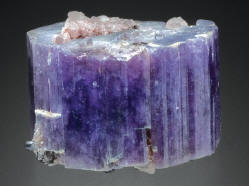
Fluorapatite, 2.6 cm wide. W. Larson collection.
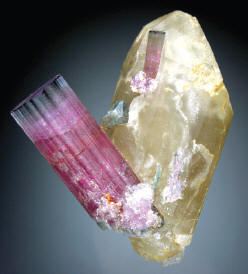
Tourmaline with quartz found in 1972, 4.5 cm high. C. Graeber collection. J. Fisher photo.
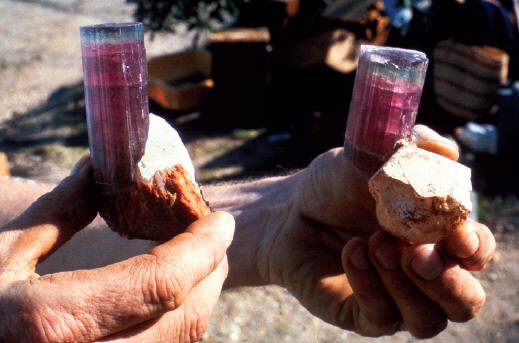
Freshly collected tourmaline specimens, around 1972. J. Scripps photo.
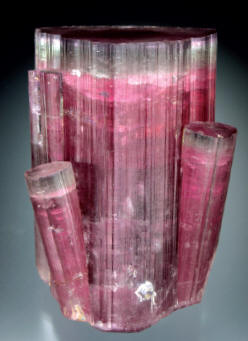
Tourmaline found in 1973, 6.5 cm high. J. Fisher and J. Kureczka collection. J. Fisher photo.
On September 25, 1968 EdwardSwoboda purchased the 30 acre patentedTourmaline Queen mining propertyfrom M. Moore and M. Wear. The nextyear he leased the property to Pala PropertiesInternational which was establishedby himself and William Larson. Adetailed history of the activity and discoveryof one of the world most famoustourmaline pockets is given in WilliamLarson's account written and publishedat the end of 1972 and is reprinted in thisissue (see at page 7).
The “blue-cap” pocket was openedon January 19, 1972 among a series ofother pockets. It was 3.5 meter long, 1.2m wide and 60 cm high in the highestplace. The majority of the tourmalineswith quartz grew downward from theceiling of the pocket. In a few days it producedmany specimens, includingaround 34 major ones. Several of themare now considered to be world-classmineral icons. All are characterized bydeep pink color of the main part of thetourmaline crystal, an intense blue toppart, high luster, flat termination and bigsize.
Descriptions of the best of the specimensgiven below should be a goodillustration of the quality of the specimens.
The huge specimen known as “Candelabra“is probably the best knowntourmaline from the “blue-cap” find. It isexhibited in the Smithsonian Institutionand illustrated here on page 11. It consistsof a 30x23 cm matrix with three 14cm long tourmalines sticking up from it.
The Candelabra needed some repairsbut even with them it is one of the bestknown specimens in the world.
A specimen called “Rabbit Ears” isnearly as famous. It is exhibited in theHouston Museum of Natural Science andis illustrated here on page 11. This specimencontains 2 main quartz crystalsfrom which two tourmaline “ears” aresticking up. Altogether it is 24 cm high.
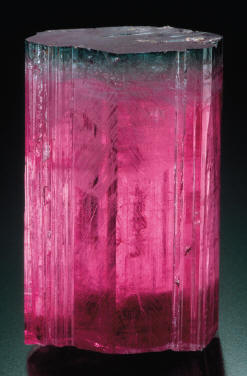
Tourmaline crystal, 4.4 cm tall. G. Meieran specimen. J. Scovil photo.
It needed some repairs and some of thequartz is damaged, but its aesthetic,color and size make it an iconic specimenoverall. Value appraised by the museumfor that piece is $15,000,000!
Another famous big specimen isnow in the Canadian Museum of Naturecollection and is shown here on page 10.
This specimen is 26 cm high and has two13 cm long tourmaline crystals standingon a group of doubly terminated quartz.
One of the most aesthetic specimenscontaining a single, huge “blue-cap” ona single quartz crystal belongs to CarlLarson. The specimen is 18 cm high, repairedbut with very dramatic aesthetics,shown here on page 9.
Another famous specimen, ownedby William H. Larson, is a cluster of two“blue-caps” with morganite betweenthem, making a superb mineralogical and coloristic composition, illustratedhere on page 12. The specimen is 15 cmhigh, and also has some repairs.
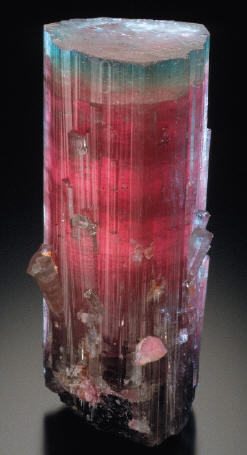
Tourmaline crystal, 10.6 cm tall. G. Meieran specimen. J. Scovil photo.
A 26 cm wide specimen of quartzwith big “blue-cap” tourmaline group isowned by the Los Angeles County Museumof Natural History; illustrated hereon page 12.
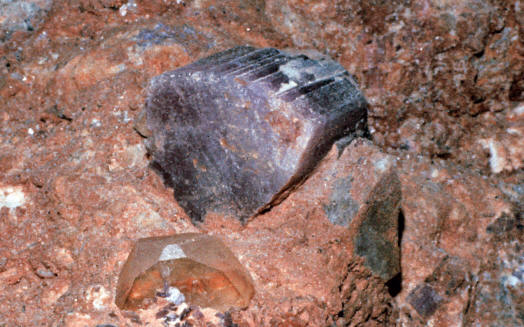
Pocket found in 1974 photographed in situ, note big morganite crystal along with tourmalines. W. Larson photo.
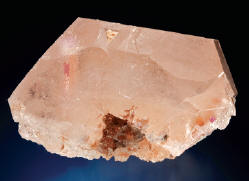
Beryl var. morganite crystal, 6 cm wide. W. Larson collection. M. Mauthner photo.










 YueGongAnBei 44051102000467
YueGongAnBei 44051102000467


 |
|